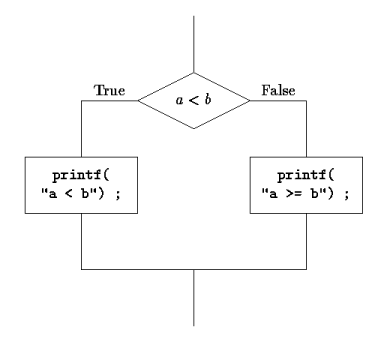if statement.
An example of this statement would be:
![]()
if( a < b ) printf( "a < b\n" ) ; else printf( "a >= b\n" ) ;
![]()

The general syntax for an if statement is:
![]()
if( expression ) statementor
if( expression ) statement else statement
![]()
else clause.
We'll take a closer look at the conditional expression later, but for now we'll list some of the expressions you'll need.
a < b - a is less than b
a > b - a is greater than b
a <= b - a is less than or equal to b
a >= b - a is greater than or equal to b
a == b - a is equal to b
a != b - a is not equal to b
|
==) instead of a single equals
sign.
The single equals sign is for assignment.
We'll look at the rationale and warn of pitfalls with this in the
next part.
There's another aspect of this new statement that is worth a word of caution here. In particular a string of characters such as:
if( a < b )is not a complete statement. So we don't put a semicolon at the end. It turns out that a line like:
if( a < b ) ; /* Don't do this */is legal C; it says that if a is less than b, then we are to do a null or empty statement. There's no good reason to ever do this since the net effect is to do nothing either way. It is almost always the case that a semicolon at the end of an
if
is a mistake.
But since it's legal, the compiler won't tell you about it.
(We'll see in Part 4 that null statements
do have uses, just not with ifs.)
The last thing to look at here is what do we do if we want to do more
than one statement in either the true or else parts of the if?
One might think that we can just list several statements one after the
other between the if and the else or after
the else.
Well, that's not quite enough.
If that were all we did, how could the compiler tell where our false
code ended and the code following the if statement began.
Such an approach would also not quite fit with the general form we saw
earlier where each branch could have only a single statement.
The answer in C is that we can group any statements into a
compound statement that can be used anywhere we can use a
single statement.
We group such statements with braces ({ and }).
For example, we might use a code fragment like:
![]()
if( a < b ) {
c = a ;
printf( "a < b\n" ) ;
}
else {
c = b ;
printf( "a >= b\n" ) ;
}
![]()
if statement will also set c to be the smaller of the two
a and b.
We'll see more about this block structuring in C
soon.
Notice also that the code in each branch of an if is usually indented. How one indents varies widely. In the examples in these lab tutorials, indentation is done in increments of three spaces. Other common amounts are two spaces, four spaces and a tab. Such indentation is not a requirement of the language, but is common practice to make the structure clear to the reader.
One last thing before moving on concerns where the braces are placed in the program. There's considerable debate on the best way to lay out the code and in where to put the braces. The style used in this tutorial is that which is used by it's author and is also the style (at least in regards to the braces) that is used in The C Programming Language by Dennis Ritchie and Brian Kernighan.
![]()
x = 5 ;
y = 7 ;
if( x >= y ) {
if( x != 6 )
printf( "A" ) ;
else
printf( "B" ) ;
}
else {
if( y != x )
if( y > 4 )
printf( "C" ) ;
else
printf( "D" ) ;
else
printf( "E" ) ;
}
![]()